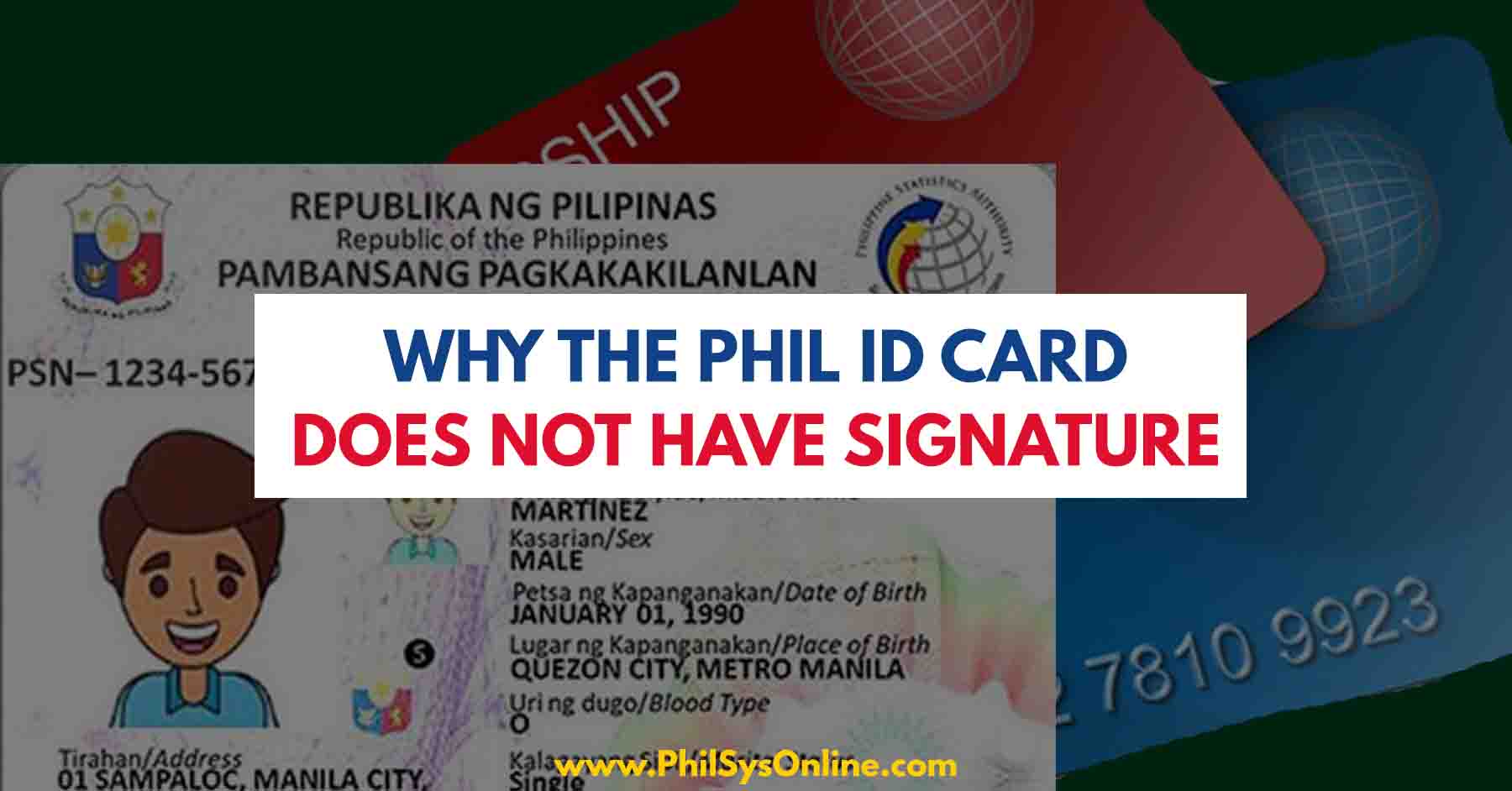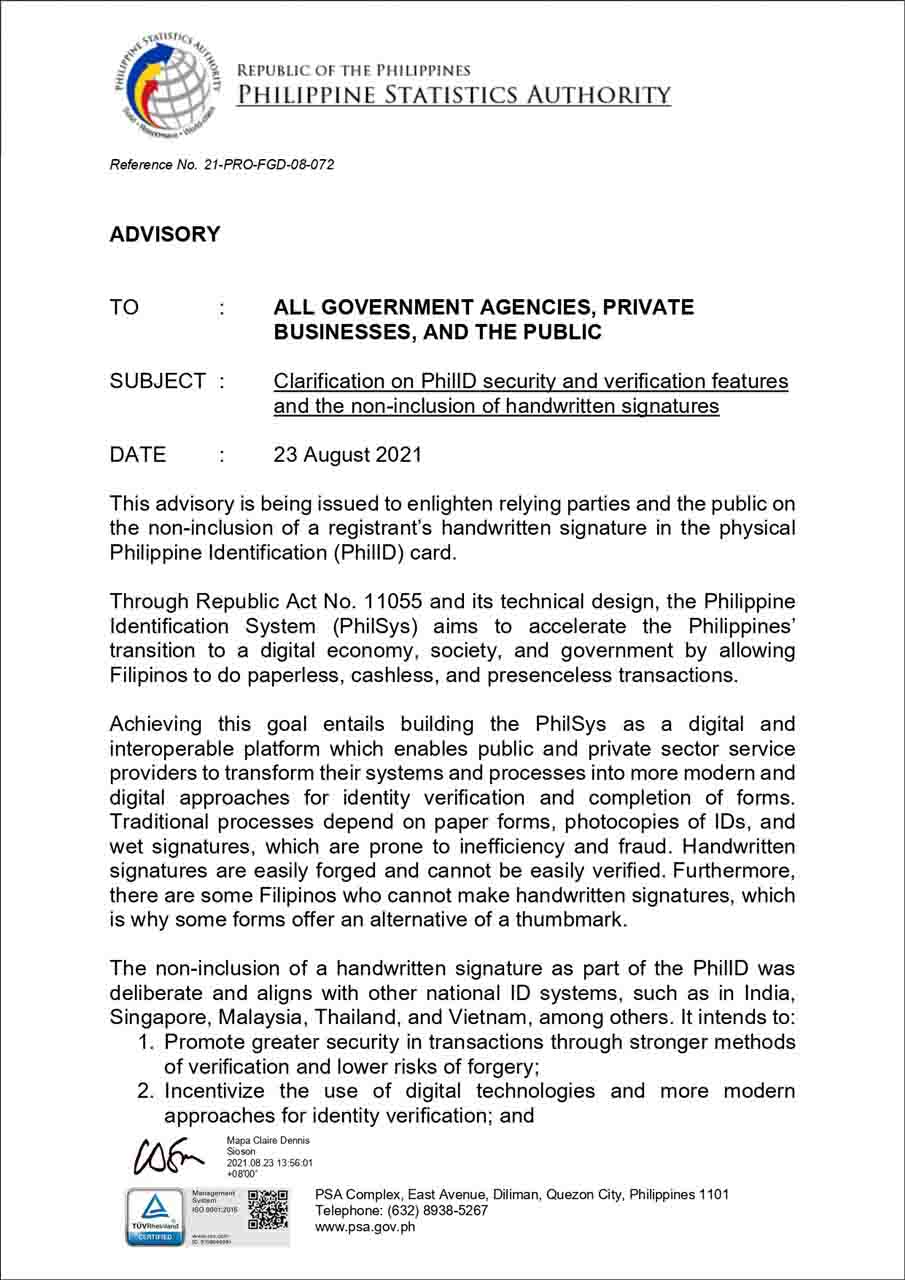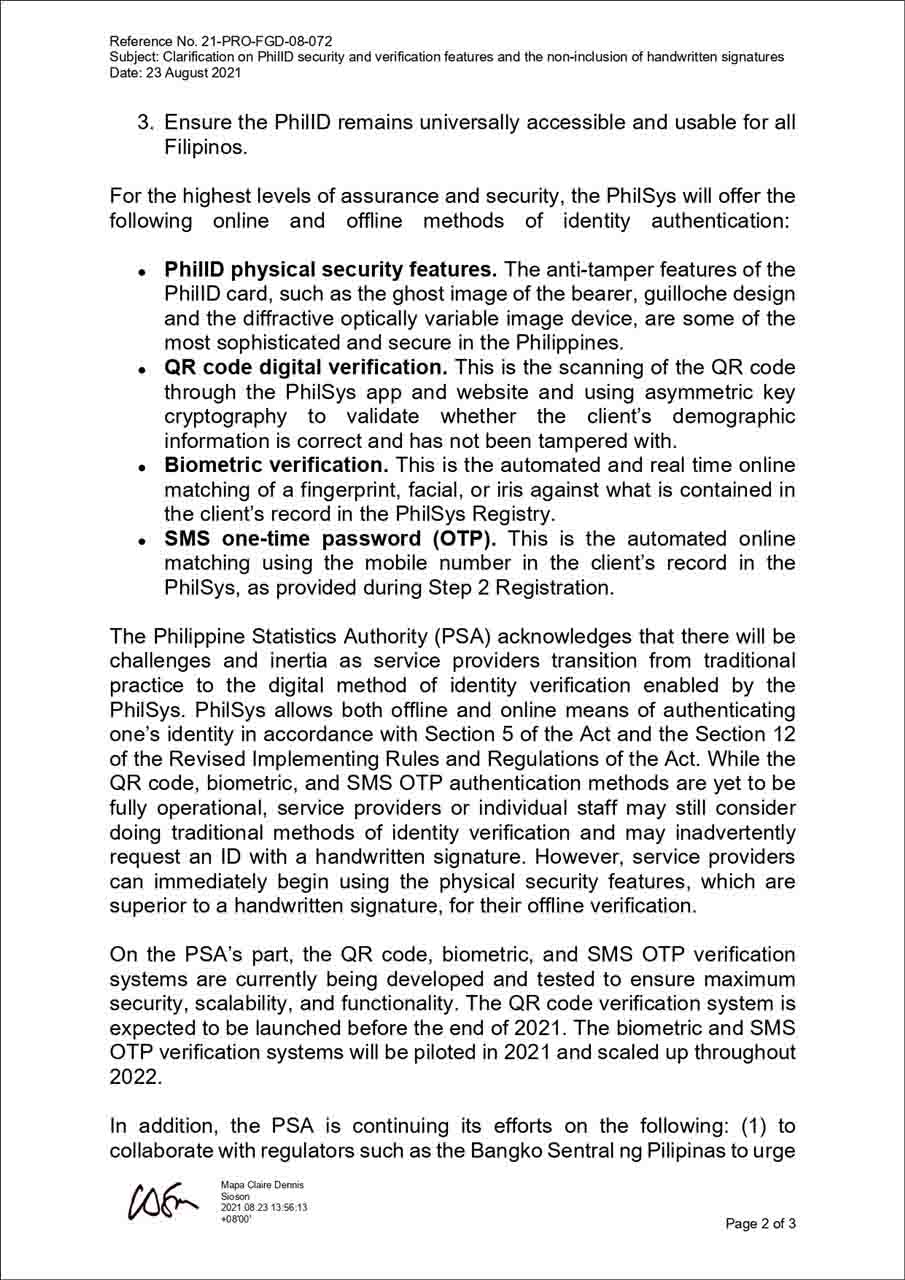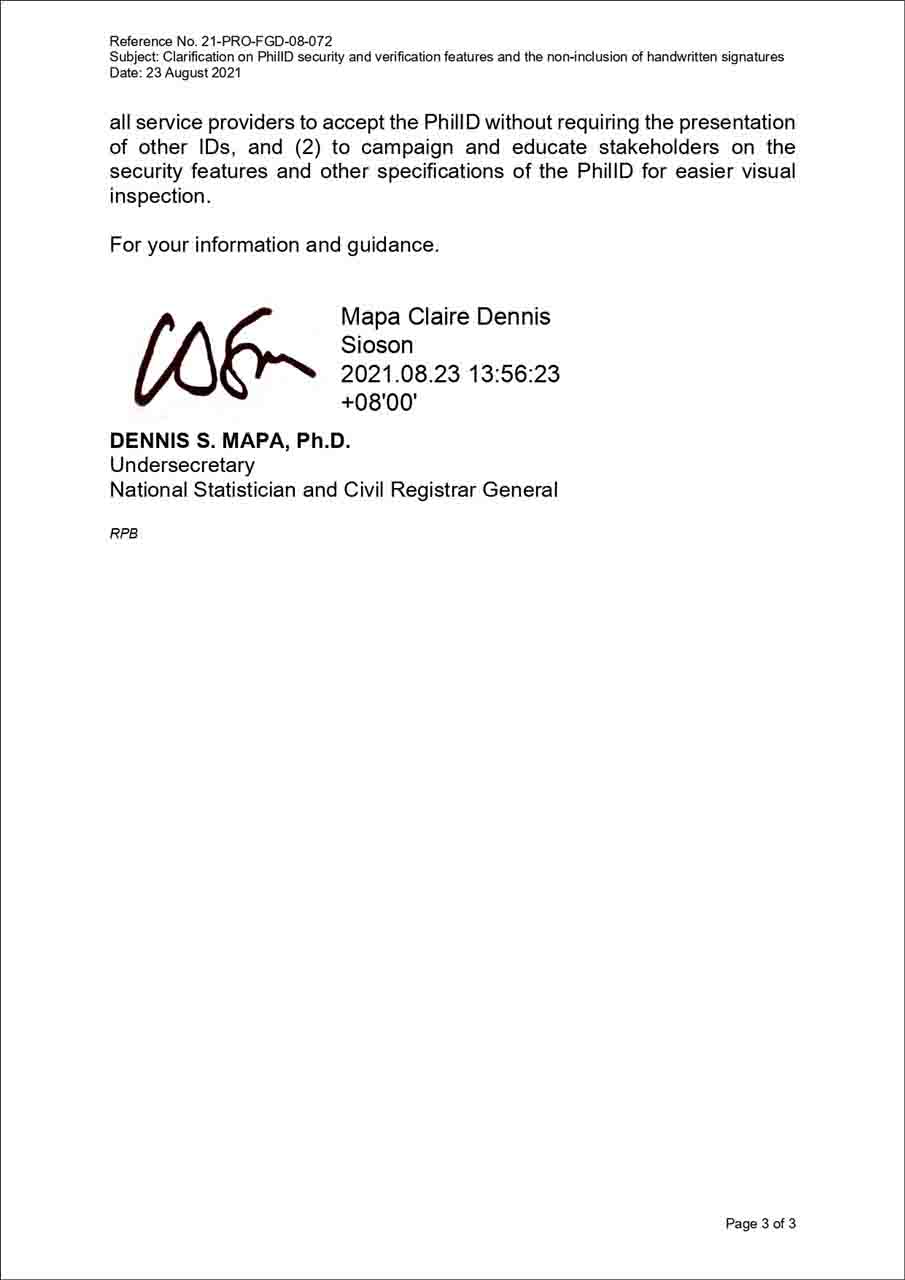Have you ever wondered why there is no signature on the PhilID? In a recent Advisory issued by the Philippine Statistics Authority dated August 23, 2021, the PhilID was designed according to more modern and more security for identity verification in order to avoid forgery, fraud, or identity theft. There is a higher chance of fraud and scams due to the traditional process such as using paper forms, photocopy of ID, and handwritten signatures.
Also Read: PhilSys Registration Step 1: How to Register and Book Appointment for National ID Online
Aside from this, a number of our fellow Filipinos have no capacity to provide a handwritten signature that is why this was replaced with a thumbmark. This was implemented by PhilSys which is why there are both online and offline methods of authenticating the identity such as the PhilID physical security features, QR code digital verification, biometric verification at SMS one-time password (OTP). These security enhancements aim for a faster and more efficient way of authentication and visual inspection of the PhilID.

3 Reasons why Handwritten Signature is Removed on the PhilID Card
The Philippine Statistics Authority provided these 3 reasons why there is no more signature on the National PhilID card:
- Promote greater security in transactions through stronger methods of verification and lower risks of forgery;
- Incentivize the use of digital technologies and more modern approaches for identity verification; and
- Ensure the PhilID remains universally accessible and usable for all Filipinos.
————–
Be PhilSys informed!
Bakit walang signature ng cardholder ang PhilID?
Ang PhilID ay dinisenyo ayon sa mas moderno at mas mataas na seguridad para sa identity verification upang makaiwas sa forgery, fraud o identity theft. Mas mataas ang tsansa ng pandaraya o panghuhuwad sa mga traditional na proseso katulad ng paggamit ng paper forms, photocopy ng ID at handwritten signature.
Bukod dito, ilan sa ating mga kababayan ay walang kakayahan magbigay ng handwritten signature kaya’t ipinapalit dito ang paggamit ng thumbmark. Ito ay naisaalang-alang ng PhilSys kung kaya’t ito ay mayroong online at offline methods para sa identity authentication tulad ng PhilID physical security features, QR code digital verification, biometric verification at SMS one-time password (OTP). Sa makabagong pamamaraang ito ay mas mapapadali ang visual inspection at authentication ng PhilID.
Here is the FB post update from PSA Philippine Identification System regarding this common question of Filipinos on why there is no signature on the card:
Video: Bakit Walang Signature ang PH National ID?
Please check out this video below which explains why there is no signature at all in our National ID card:
PSA Advisory: Clarification on PhilID security and verification features and the non-inclusion of handwritten signatures
Please check out the full Advisory from the Philippine Statistics Authority regarding the safety features and security of the Phil ID:
| TO | : | ALL GOVERNMENT AGENCIES, PRIVATE BUSINESSES, AND THE PUBLIC |
| SUBJECT | : | Clarification on PhilID security and verification features and the non-inclusion of handwritten signatures |
| DATE | : | 23 August 2021 |
This advisory is being issued to enlighten relying parties and the public on the non-inclusion of a registrant’s handwritten signature in the physical Philippine Identification (PhilID) card.
Through Republic Act No. 11055 and its technical design, the Philippine Identification System (PhilSys) aims to accelerate the Philippines’ transition to a digital economy, society, and government by allowing Filipinos to do paperless, cashless, and presenceless transactions.
Achieving this goal entails building PhilSys as a digital and interoperable platform that enables public and private sector service providers to transform their systems and processes into more modern and digital approaches for identity verification and completion of forms. Traditional processes depend on paper forms, photocopies of IDs, and wet signatures, which are prone to inefficiency and fraud. Handwritten signatures are easily forged and cannot be easily verified. Furthermore, there are some Filipinos who cannot make handwritten signatures, which is why some firms offer an alternative of a thumbmark.
The non-inclusion of a handwritten signature as part of the PhilID was deliberate and aligns with other national ID systems, such as in India, Singapore, Malaysia, Thailand, and Vietnam, among others. It intends to:
- Promote greater security in transactions through stronger methods of verification and lower risks of forgery;
- Incentivize the use of digital technologies and more modern approaches for identity verification; and
- Ensure the PhilID remains universally accessible and usable for all Filipinos.
For the highest levels of assurance and security, the PhilSys will offer the following online and offline methods of identity authentication:
- PhilID physical security features. The anti-tamper features of the PhilID card, such as the ghost image of the bearer, guilloche design, and the diffractive optically variable image device, are some of the most sophisticated and secure in the Philippines.
- QR code digital verification. This is the scanning of the QR code through the PhilSys app and website and using asymmetric key cryptography to validate whether the client’s demographic information is correct and has not been tampered with.
- Biometric verification. This is the automated and real-time online matching of a fingerprint, facial, or iris against what is contained in the client’s record in the PhilSys Registry.
- SMS one-time password (OTP). This is the automated online matching using the mobile number in the client’s record in the PhilSys, as provided during Step 2 Registration.
The Philippine Statistics Authority (PSA) acknowledges that there will be challenges and inertia as service providers transition from traditional practice to the digital method of identity verification enabled by PhilSys. PhilSys allows both offline and online means of authenticating one’s identity in accordance with Section 5 of the Act and Section 12 of the Revised Implementing Rules and Regulations of the Act. While the QR code, biometric, and SMS OTP authentication methods are yet to be fully operational, service providers or individual staff may still consider doing traditional methods of identity verification and may inadvertently request an ID with a handwritten signature. However, service providers can immediately begin using the physical security features, which are superior to a handwritten signature, for their offline verification.
On the PSA’s part, the QR code, biometric, and SMS OTP verification systems are currently being developed and tested to ensure maximum security, scalability, and functionality. The QR code verification system is expected to be launched before the end of 2021. The biometric and SMS OTP verification systems will be piloted in 2021 and scaled up throughout 2022.
In addition, the PSA is continuing its efforts on the following: (1) to collaborate with regulators such as the Bangko Sentral ng Pilipinas to urge all service providers to accept the PhilID without requiring the presentation of other IDs, and (2) to campaign and educate stakeholders on the security features and other specifications of the PhilID for easier visual inspection.
For your information and guidance.


